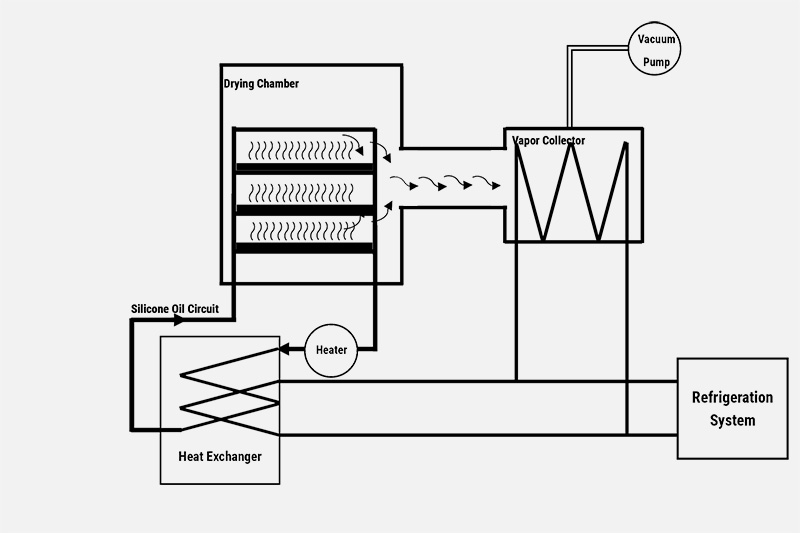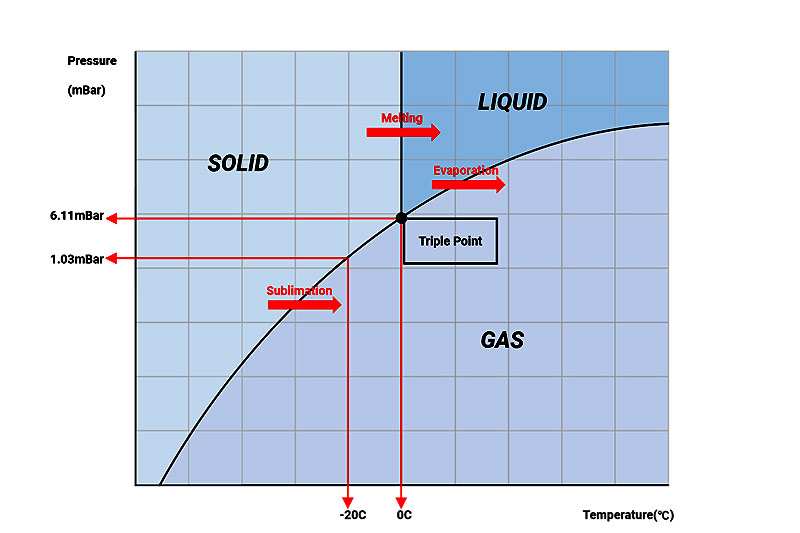What’s Freeze Drying
Vacuum freeze drying and lyophilization is one of the best recognized dehydration methods. Famous for drying products without be degraded. Well maintain its active ingredient, vitamins, color and appearance.
Brief Introduction
Freeze drying or lyophilization, is a low temperature dehydration method, it removes water and uses a technology called sublimation. The process starts from raw products freezing, to enable water turn to ice, then reduce the drying chamber pressure to create vacuum environment, the frozen water absorb heat from surroundings and will sublimate directly from solid to gas. By this, the water inside raw products is success comes out.
Vacuum Freeze Drying
There are many industrial applications in which substances need to be dried gently, to preserve their active ingredients. Typically, dry at minus temperature and in a pressure-tight environment is the most feasible solution.
Before freeze dry, raw products need to be frozen to -10C ~ -60C. And depending on application fields, to minimum the cross-contamination risk, the processing equipment have to be high control performance, capable of in-place freezing, drying and pressure control.
Vikumer engineers series of advanced freeze dryers and lyophilizers suitable for lab trials and commercial production. These robust systems can precisely control vacuum degree and chamber temperatures, so that create ideal freeze drying condition. Products can be dried quickly and gently.
Here is the water remove process in a freeze dryer diagram:

Here is the principle of sublimation: Diagram of water 3 phases.

Conventional Drying vs Freeze Drying
Conventional drying is the most common drying method, this type of drying equipment simply apply heat to products, to enable the water boil to vapors, and come out. Generally, conventional drying methods include hot air dry and vacuum dry, each of them also has subclassifications.
The biggest difference between freeze drying and conventional drying (vacuum drying, spray drying, hot air drying etc.) is the temperature that use to remove water. Freeze drying process below 0C, while others typically higher than 30C.
| Hot Air Dry | Vacuum Dry | Freeze Dry | |
|---|---|---|---|
| Pressure | N/A | 1000~5000mbar | <1mbar |
| Temperature | >80C | 30~80C | <0C |
| Degrade | Yes | Slightly | No |
| Appearance | Shrink | Slightly Change | No |
| Cost | Low | Middle | High |
| Production | Continues | Continues | Batch |
| Productivity | High | Middle | Low |
From above form of freeze drying and conventional drying comparation:
- Conventional drying methods detract from product quality, because of the high temperature. Final products appearance may shrink and hard. As well as the oxidation cause products degradation, to nutritional and color properties. Although new technology like vacuum drying (with microwave or infrared heating etc.), which lower temperature is applied, but for heat sensitive materials, nutrient loose is inevitable.
- Freeze drying offers highest dried quality, and thus, for some very heat sensitive materials, it is the only drying method. The disadvantage of freeze drying is, batch production low productivity, and quite long batch duration, which is, the cost is quite high.
What’s vacuum freeze drying?
Vacuum freeze drying or lyophilization is a water remove process, which based on batch operation. It works by freeze the raw products, and then move them to an air-tight vessel, lowering the internal pressure, the frozen water will start sublimating. By this, water is success removed.
Freeze Dry Heat-Sensitive Materials
Freeze drying is one of the foremost industrial drying techniques for heat-sensitive materials. And also, is the only method to deliver stable, biologically active products with a long shelf life. This low temperature drying method offers tons of benefits, to varies industries:
Pharmaceuticals: High temperature process may kill the active ingredients and lose their medicinal effect.
Food Drying: Conventional drying methods with high temperature surely will break down nutrients. And degrade taste, appearance and vitamin.
Chemicals and Biologicals: Temperature influence molecular structure and stability a lot. Conventional drying cannot guarantee the final dried product quality.
Freeze Dryers are Batch Production Machines
Because the drying chamber is air-tight and pressurized. And during freeze dry, the chamber always negative pressure. So, it is impossible to load or unload materials in midway of the drying process.
The Vikumer freeze drying machines are batch processing equipment. The temperature and pressure can be accuracy controlled, to create the ideal environment for product drying.
How Is the Water Removed During Freeze Drying?
Freeze drying removes water by use of sublimation technology: below the water triple point, solid water can directly turn to gas form, without pass through liquid phase.
Within the Vikumer vacuum freeze drying machines, the exhaust vapor is collected by a cryogenic condenser. When vapor hit low temperature condenser, it will be condensed to ice form. When drying finish, melt to water and discharge.
The water removing is in a completely closed-circuit system. Hygienic to raw material, no environmental threats and employee’s health hazards.
Common Applications of Freeze Drying
Freeze drying is frequently used in food drying, pharmaceutical production, health care products, biological products and chemical processing. Diverse industries and applications, read more of freeze drying applications.

